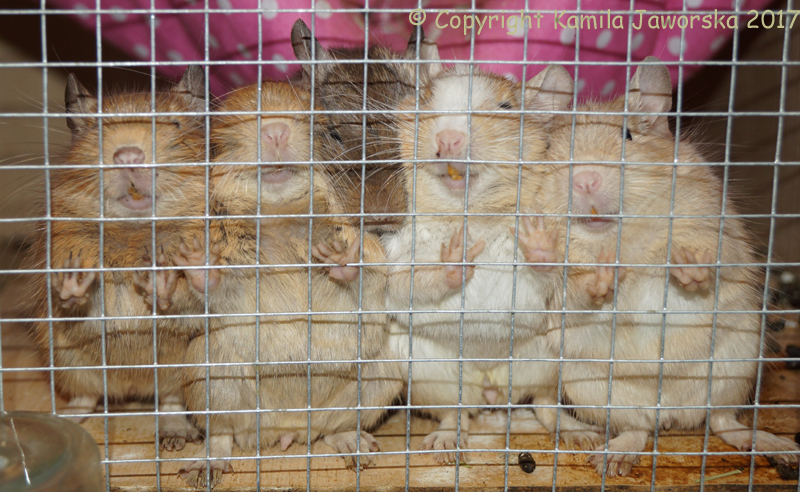Until recently, there was very
little information on coat colour variations in degus. Now these varieties are
becoming more common, on this page you will find information and pictures about
the different types being bred.
This information was compiled in collaboration with Kamila Jaworska


Before we get started, it should be pointed out that breeding degus for their coat colour is not always a good idea, and should always come second to breeding degus for their health. Many colour variations are caused by a recessive gene, meaning the degus have a history of being directly inbred to produce the colour strain. This means that the health of these coloured degus often suffers, and many have a greatly reduced lifespan as compared to agouti varieties. You might want to read a short article titled 'The Eye of the Beholder: Natural beauty Vs. the ignorant breeder' to find out more. Several breeders in Europe are working hard to try and correct these problems in coloured degus, which we support 100%!
>The Fundamentals of Coat Colour in the Degu<
Coat colour in mammals is determined by the presence or absence of pigment within the hair shaft. There are only two types of pigment: eumelanin (black) and pheomelanin (red);
the extent of these pigments in the hair, and therefore the colour, is controlled by certain genes which we will discuss below.
The natural coat colour of the degu is a light agouti, which refers to a banding of the hair shaft colour. A natural agouti degu coat has bands of dark eumelanin at the
base and tip, and a band of lighter pheomelanin in the middle.
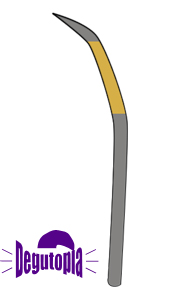

Structure of an agouti hair
This colour has evolved in degus to act as natural camouflage in
their wild habitat. Two of the first colour variations bred were 'black' (very
dark brown) and 'blue' (light grey). This is likely to have arisen due to a
chance mutation in the expression of pheomelanin. These colours originated in Germany and the Netherlands, and
are spreading across Europe (in particular Sweden and Finland) due to their
novelty.
Before you read on, you might
like to know a little bit about colour genetics. Coat colour is expressed in one
of two forms; homozygous or heterozygous. The term 'homozygous' means that degu
has two copies of the same allele (one half of the neucleotide coding that makes
up the whole gene) to make up the colour gene. On the other hand, a
'heterozygous' degu has one allele corresponding to a colour in one form, and one allele
corresponding to a colour in another form. The allele that gets expressed in the
phenotype (outward appearance) is the one that is dominant over the other (the
other is termed 'recessive'). A good example of this is human hair colour- if a
person with homozygous brown hair produces a child with a person with homozygous
blonde hair, the child will be born with brown hair no matter if they're
homozygous or heterozygous for the brown colour, since brown hair is dominant
over blonde hair. Easy!
You should also be aware of the effect of different loci on coat colour (a locus is
a special point on the allele that has a specific effect on the phenotype). We currently know of six distinct loci that are important to coat colour in degus:
Locus A: 'Agouti' locus - responsible for banded hair (dominant A) or single-colour hair (recessive aa)
Locus B: 'Brown' locus - responsible for expression of eumelanin (dominant B) and pheomelanin (recessive bb)
Locus C: 'Colour' locus - responsible for presence of pigment (dominant C) or absence of pigment (recessive cc)
Locus D: 'Dilution' locus - responsible for pigment dilution in recessive dd form
Locus E: 'Extension' locus - responsible for pigment extension in the hair shaft in recessive ee form
Locus W: 'White patching' locus - responsible for white patches in the coat (dominant W)
We can therefore use these loci to create a 'coat colour code' for a particular degu, for example a homozygous natural agouti degu would have the following code:
AA BB CC DD EE ww
Meaning the coat has agouti banding, expresses eumelanin pigment that is not diluted or extended, and is not white patched.
It is worth noting that locus A and locus E are linked in the degu, due to the interaction of Agouti Signalling Protein (ASIP) coded at locus A and Melanocortin
1 Receptor (MC1R) coded at locus E.
>NATURAL AGOUTI DEGUS<
CODE = A* B* C* D* E* ww
The natural, light agouti coat colour of the degu is dominant over all other colour types (with the exception of white patching; see below). Therefore,
crossing two homozygous agouti degus will result in the following:
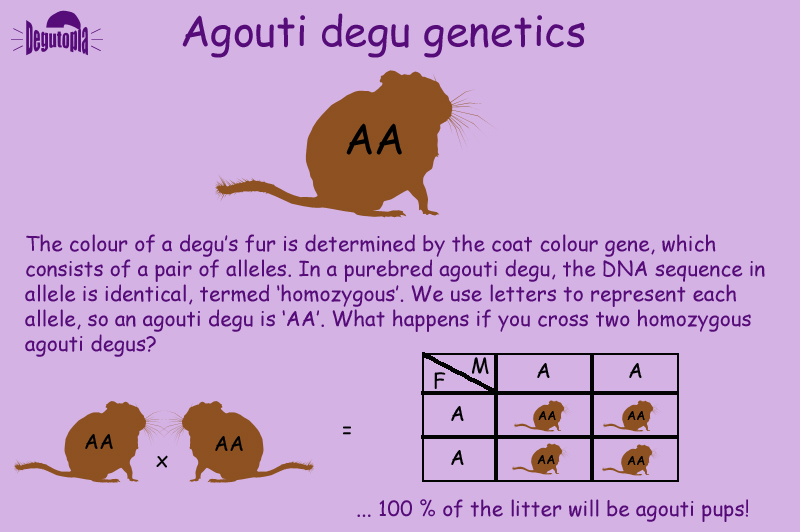
>"BLUE" DEGUS<
CODE = A* B* C* dd E* ww (agouti form)
CODE = aa B* C* dd E* ww (single-colour form)
Blue degus are homozygous for a recessive copy of the dilution gene, causing eumelanin to be 'diluted' into a grey colour.
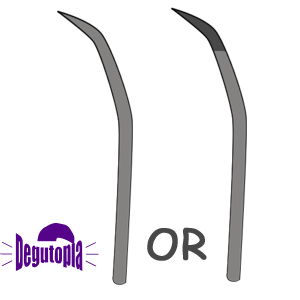
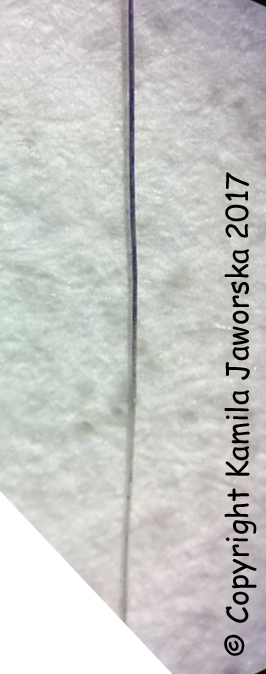
Structure of a blue hair
Notice how the 'brown' band that is present in the natural agouti hair is missing in the blue hair, producing a coat that is entirely grey (sometimes with a darker grey tip).
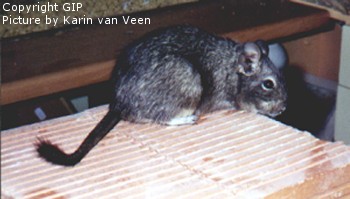
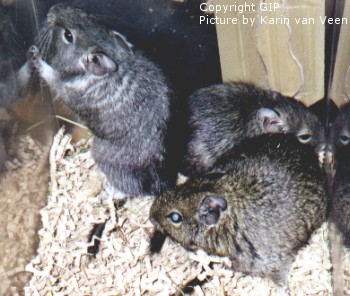
The above pictures show adult
blue degus, the name of the colour reflecting their unusual blue-grey coats. You
can see in the right hand picture the contrast with the natural agouti degu
(pictured bottom right with cataracts). These are blue agouti form degus, because the hairs still have the agouti banding of light and dark grey.
This coat type is known to be
genetically recessive, meaning you need to breed two blue degus together to get
a complete litter of blue pups. Breeding a blue degu with a homozygous natural agouti
degu will result in only natural agouti pups, some of which will carry the gene for the
blue colour (termed 'heterozygous'). Breeding two natural agouti heterozygous carriers
together will result in roughly one quarter of the litter being born blue, one
quarter born homozygous natural agouti and one half born heterozygous natural agouti. You can
see why the initial breeders had problems producing healthy blue degus without
resorting to inbreeding to produce more blue pups.
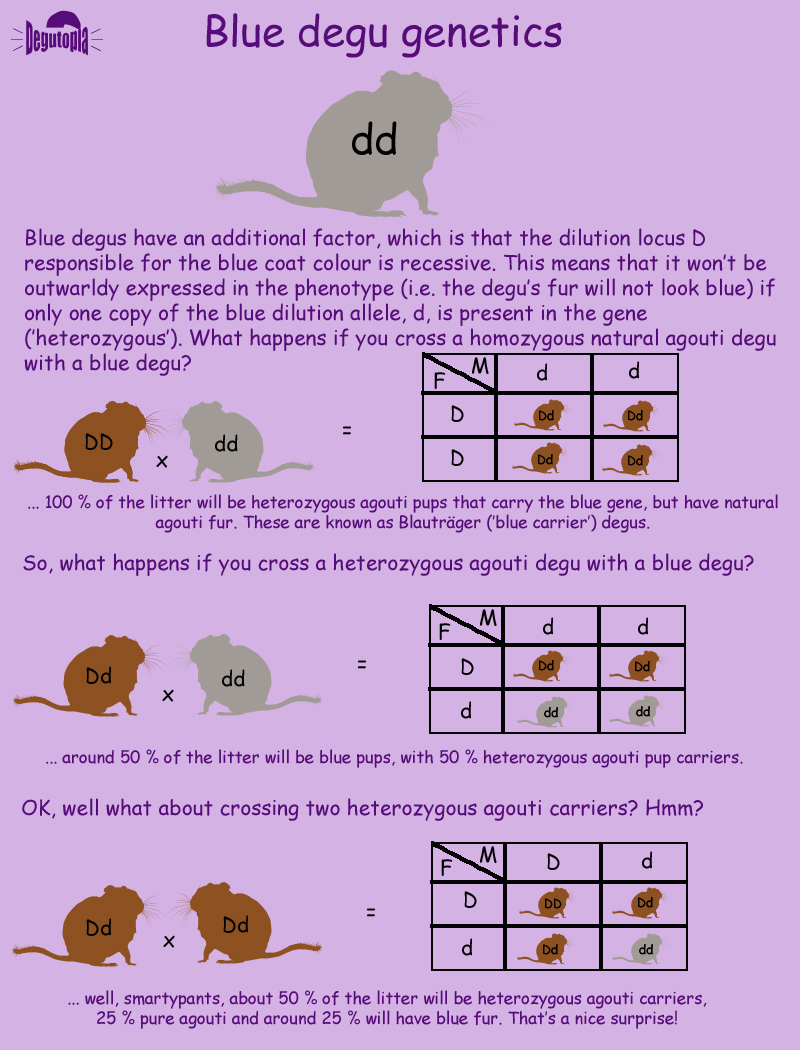
Below are shown some blue single-colour form
degu pups only a few days old. You can see that the coat is much lighter because it lacks the dark grey banding of the agouti form. The genetics of this blue
variant are slightly different to the agouti form and they are much less common.
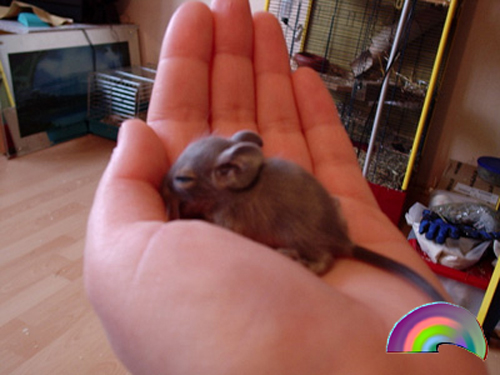
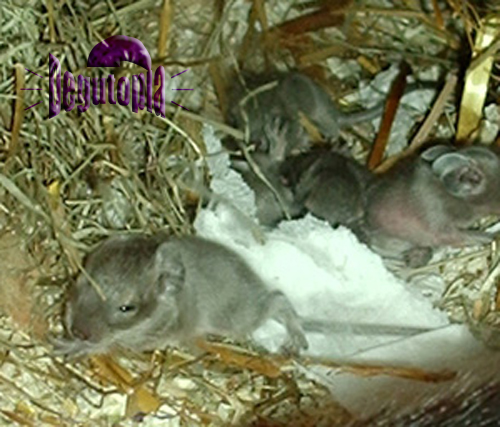
Adult blue degu pictures ©
copyright Karin van Veen (Netherlands); blue degu pup pictures © copyright Julia
Riedel (Germany)- it is unlawful to take these pictures without permission of
the copyright holder.
>"CHAMPAGNE AGOUTI"/"CHAMPAGNE BLUE" DEGUS<
CODE = A* B* C* dd E* ww
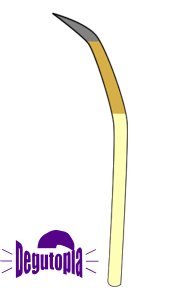
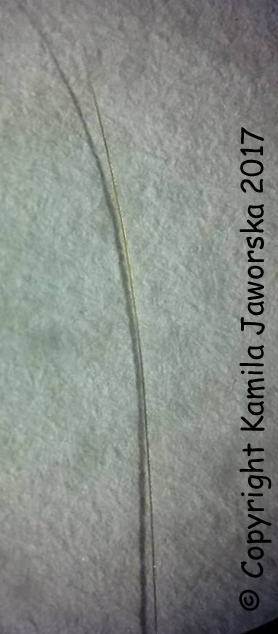
Structure of a champagne agouti hair
In this colour variety, the agouti banding is still present, but rather than having a grey undercoat, the base of the hair is a pale cream colour. Compare the difference
in colour between the agouti hairs (left) and the champagne agouti hairs (right) in the image below:
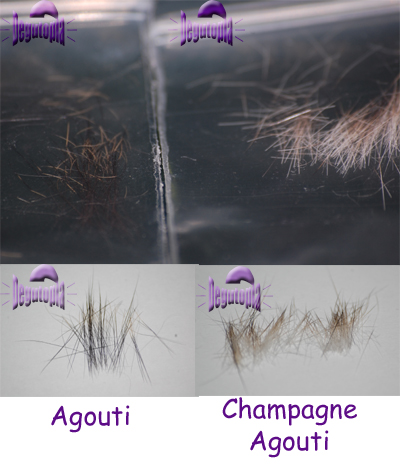
...And how the underfur compares between an agouti degu and a champagne agouti below:
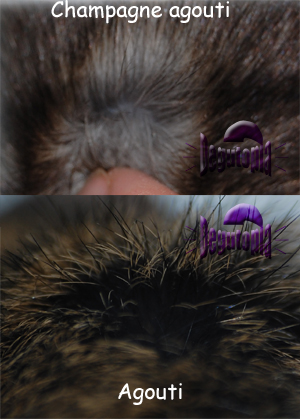
This difference is caused by the same dilution gene that causes the blue coat colour, but the pheomelanin band in the hair shaft is also expressed. This mutation
is relatively new and champagne agouti degus are often mistaken for being 'blue'. The genetics are very similar to those of the blue degu.
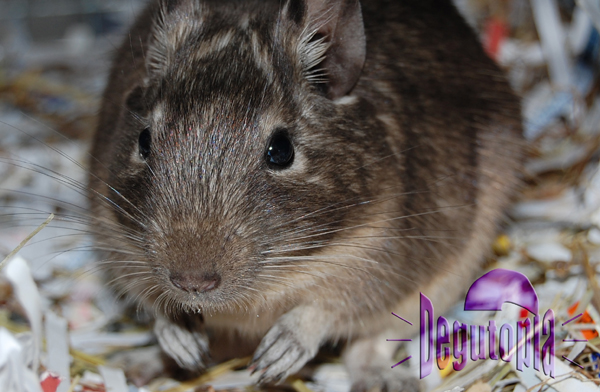
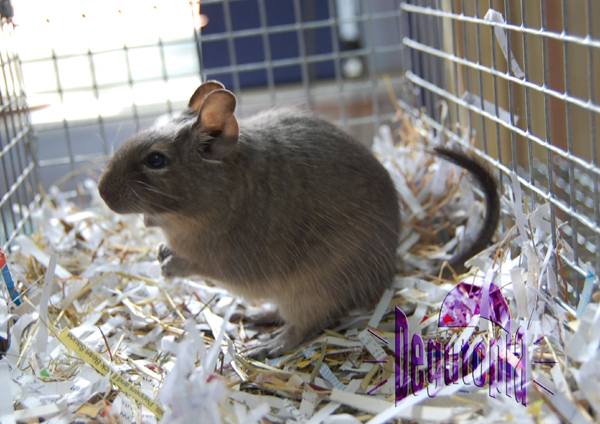
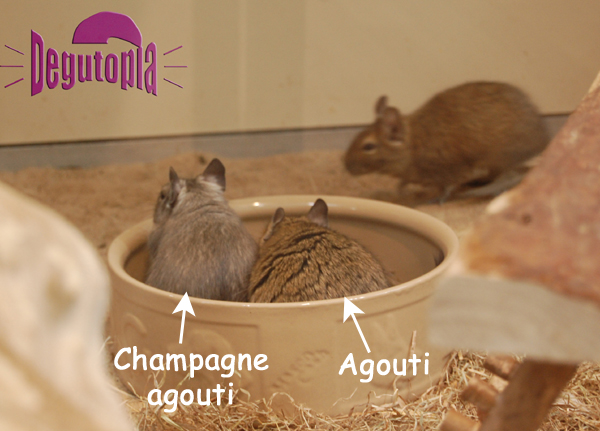
Adult champagne agouti degu pictures ©
copyright Chloe Long (UK) 2011- it is unlawful to take these
pictures without permission of the copyright holder.
>"BLACK" DEGUS<
CODE = aa B* C* D* E* ww
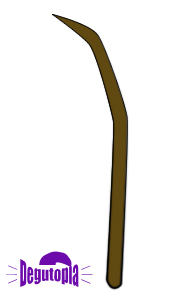
Structure of a black hair
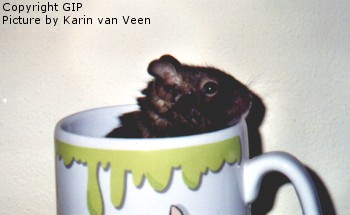
Black degus are actually a
very dark shade of brown due to the presence of eumelanin throughout the hair shaft, and are very uncommon. There is no agouti banding. Very little is known about the
genetics of this colour variety and the degu in the above picture may well be a
unique example. Nevertheless, this is one of the first examples of a colour
mutation in the degu's coat.
Adult black degu picture ©
copyright Karin van Veen (Netherlands)- it is unlawful to take these pictures
without permission of the copyright holder.
>"SAND" DEGUS<
CODE = A* B* C* D* ee ww
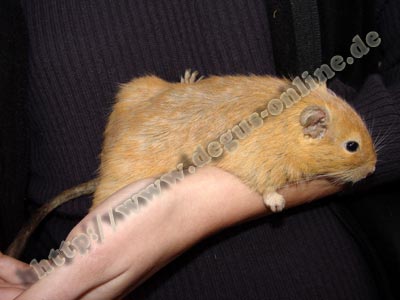
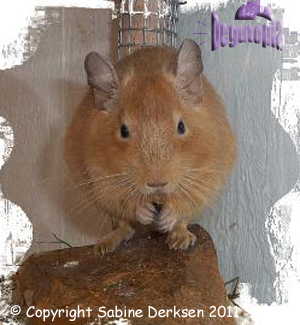
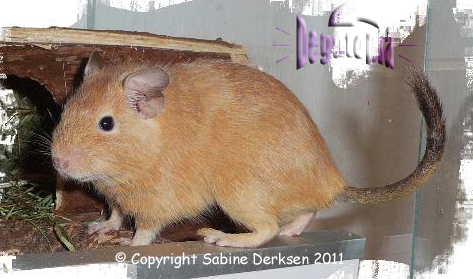
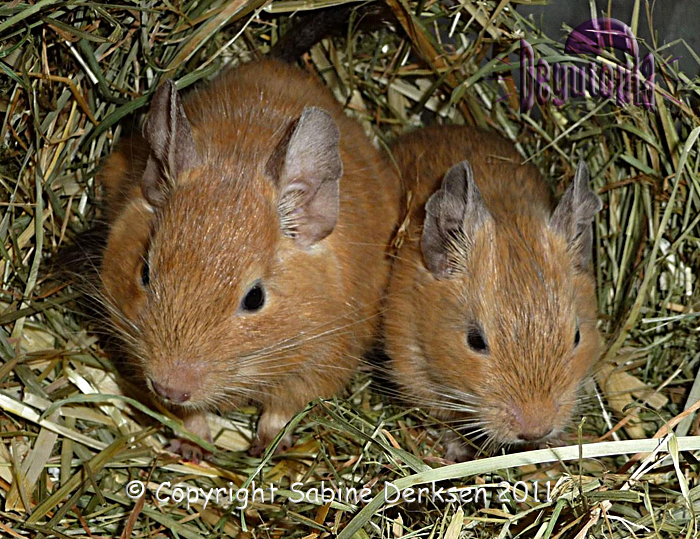
Another unusual colour
variety, the sand degu, has an almost ginger coat. The top picture shows the initial strain, which was reportedly bred in
the USA and imported into Germany. This first variation was reported to have very un-degu like characteristics (the degu
pictured is a particularly large example) and were not commonly bred due to their numerous health defects as reported by Degus-Online.de . This particular
strain is thought to have died out because of this. However, it has recently been reported by Sabine Derksen and Melanie Nickel (TraumDegus.de) that a new, much healthier
strain of the sand colour is currently being developed in Germany (see the three lower pictures). The picture below shows a more recent example of a sand degu.
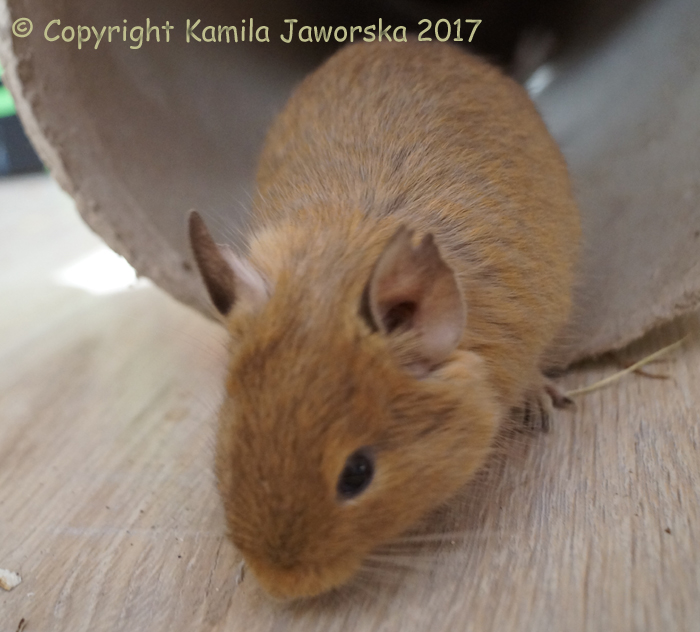
The colour is reportedly a recessive trait and is caused by the
interaction of the extension locus with the expression of pheomelanin, causing it to be present throughout the hair shaft while at the same time surpressing
eumelanin expression. The more recent sand degus produced
do not have markedly different health or longevity compared to other degus.
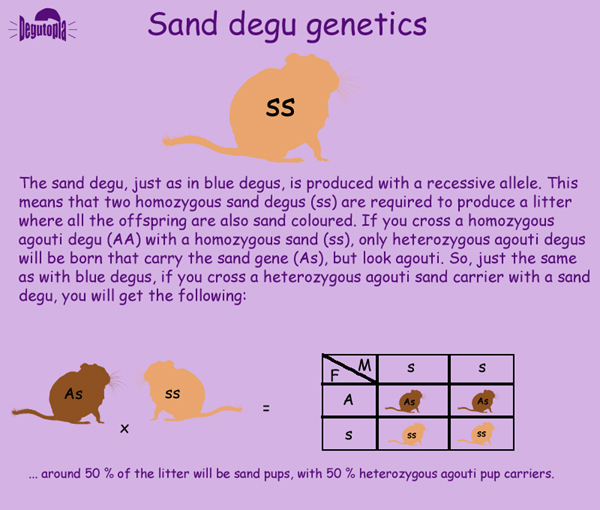
Adult sand degu picture (top) ©
copyright Sabine Gehrsitz (Germany, Degus-Online) & Nina Sogn (Germany); Adult sand degu pictures (middle and lower)
© Sabine Derksen and Melanie Nickel (Germany, TraumDegus); Adult sand degu picture (bottom) © copyright Kamila Jaworska (Poland, DEGU Stacja)- it is unlawful to take these pictures without
permission of the copyright holder.
>"CREAM" DEGUS<
CODE = A* B* C* dd ee ww
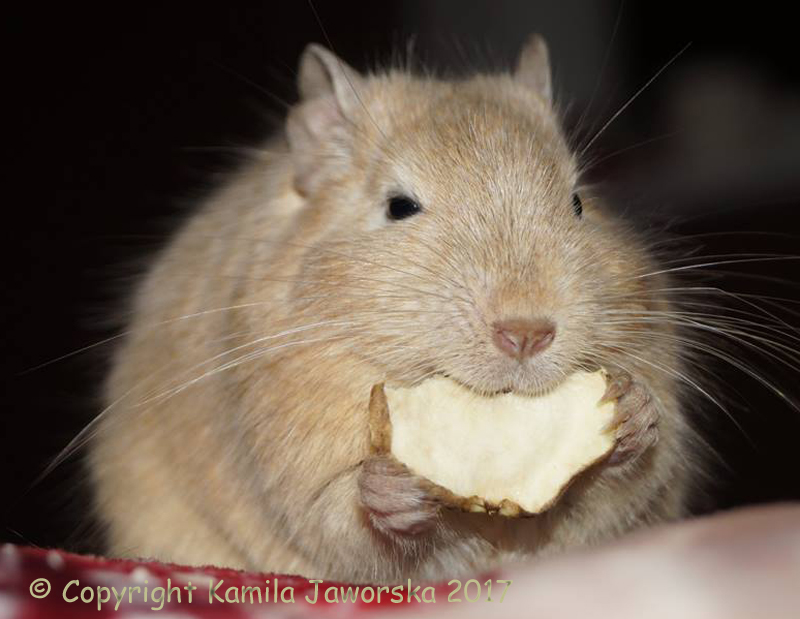
Cream degus can be tricky to find because this colour is produced by two recessive alleles on two loci, dilution and extension. It occurs when the sand colour
is diluted in the coat, just as it is in the blue degu. You can therefore produce a cream coat by crossing a blue and a sand degu, as shown below. You will
notice that the odds of producing a cream coat are very low, and can only be obtained in a second generation sand/blue cross. The odds of producing a cream
coat increase with a third generation blue or sand carrier cross, but the risks associated with inbreeding become much higher and great care must be taken
when breeding this colour variety.
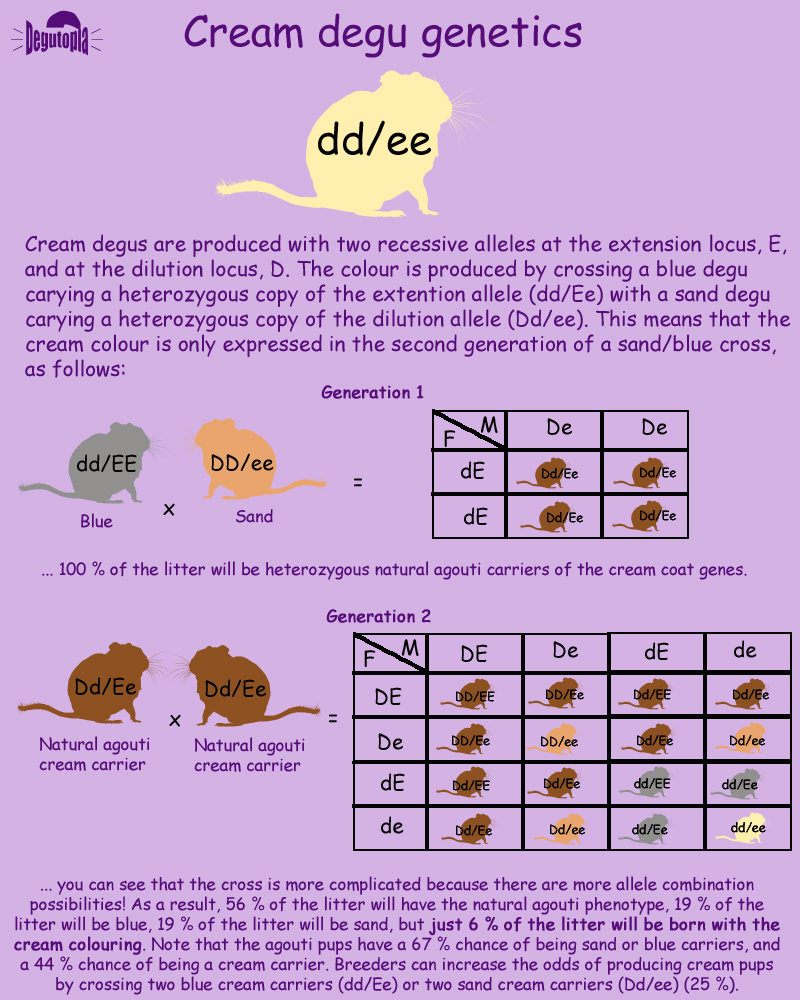
Adult cream degu picture ©
copyright Kamila Jaworska (Poland, DEGU Stacja)- it is unlawful to take these pictures
without permission of the copyright holder.
>"WHITE PATCHED/SCHECKE" DEGUS<
CODE = * * C* * * W*
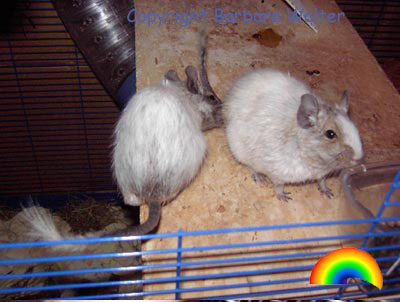
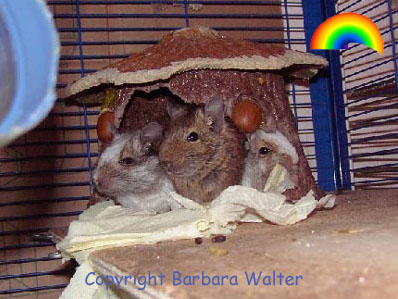
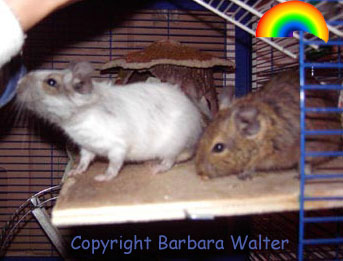
The white patched degu is becoming a
popular colour variety, particularly in Germany and Finland, where they are known as 'schecke' (patched). These degus are
usually natural agouti with areas of unpigmented skin, producing patches of white fur
all over the body. Early reports suggested that white patches are a dominant trait (Mayer, 2008-
personal communication), and we now know this to be the case (see below).
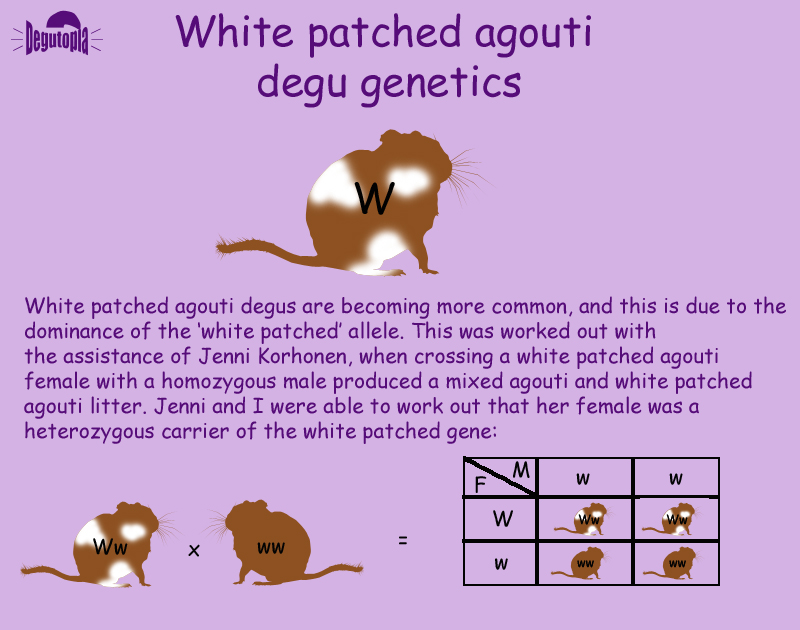
White patching can occur in any colour variety as it is caused by a separate locus (W).
Below are some pictures of white patched natural agouti degu pups, only a
few weeks old. One picture clearly shows the difference between the patched degu
and their littermates.
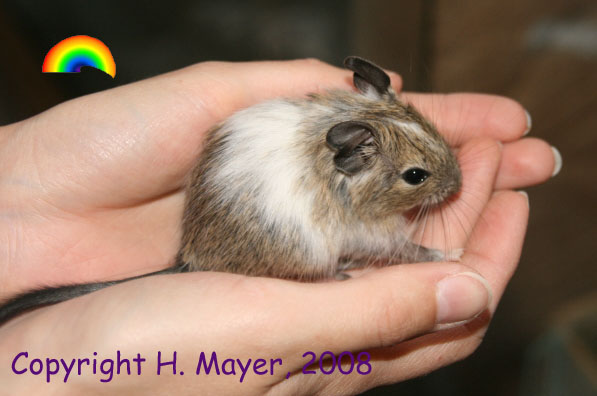
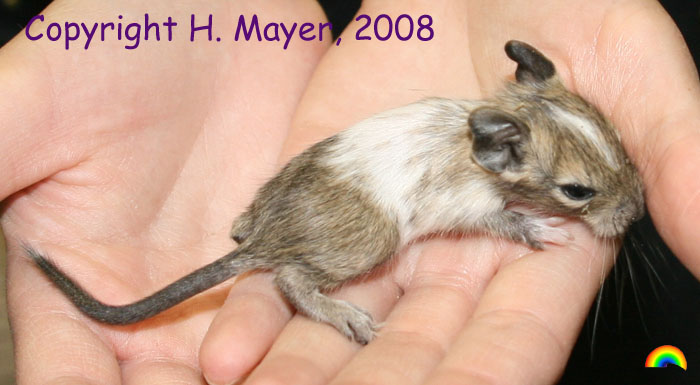
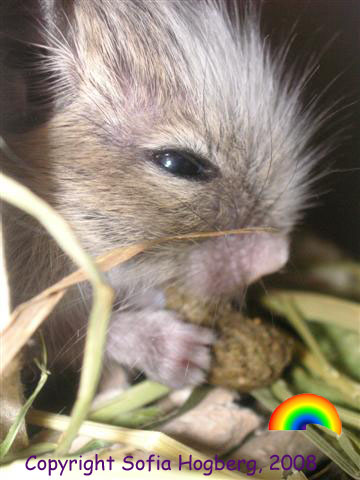
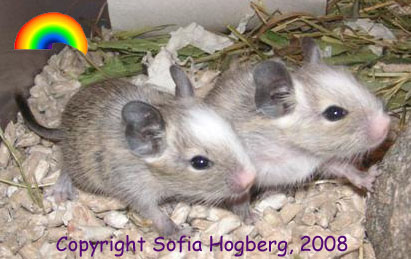
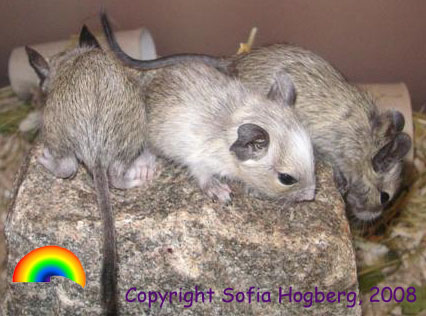
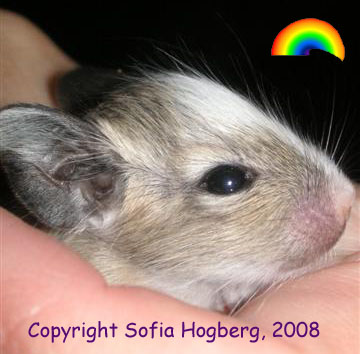
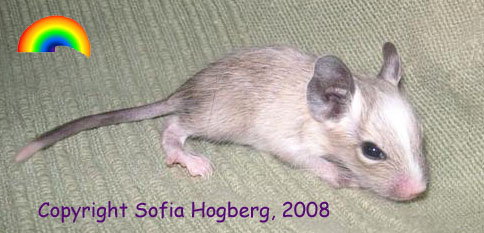
The ammount of patching in the degu's coat determines the type according to the following categories, used widely in Germany and throughout Europe:
Punktschecke - 'dot patched': < 5 % of the coat is white patched
Schecke - 'patched': 5 - 50 % of the coat is white patched
Starkschecke - 'strong patched': 50 - 80 % of the coat is white patched
Superschecke - 'super patched': > 80 % of the coat is white patched
The image below shows an example of a sand starkscheke degu:
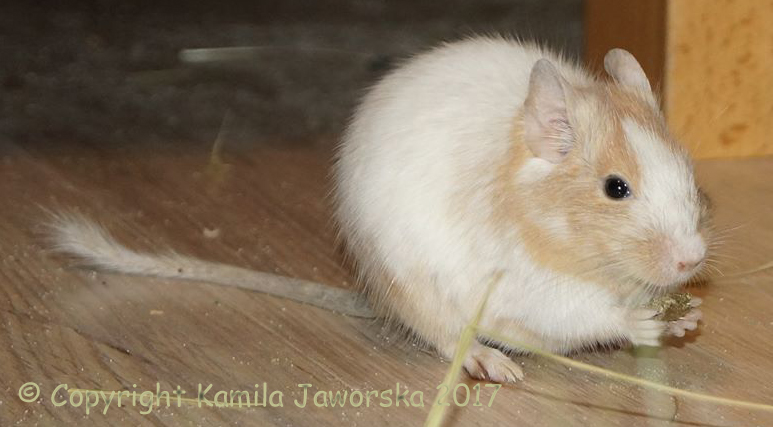
Adult patched degu pictures ©
copyright Barbara Walter (Unknown); Patched degu pup pictures © copyright Hanni
Mayer (Germany) and Sofia Hogberg (Sweden) 2008; Sand superschecke degu © copyright Kamila Jaworska (Poland, DEGU Stacja) 2017- it is unlawful to take these
pictures without permission of the copyright holder.
>OTHER "PATCHED" DEGUS<
It is not only degus born with
white patches that can end up with unusual white markings. There is also a rare
genetic mutation that causes white patches to develop on degus as they age, even
if they have been born with agouti fur and remained patch-free for several
years. These patches often occur on the degu's back and are not related to old
injury sites. The degu below, Eddy, developed this white patch when he was 4
years old:
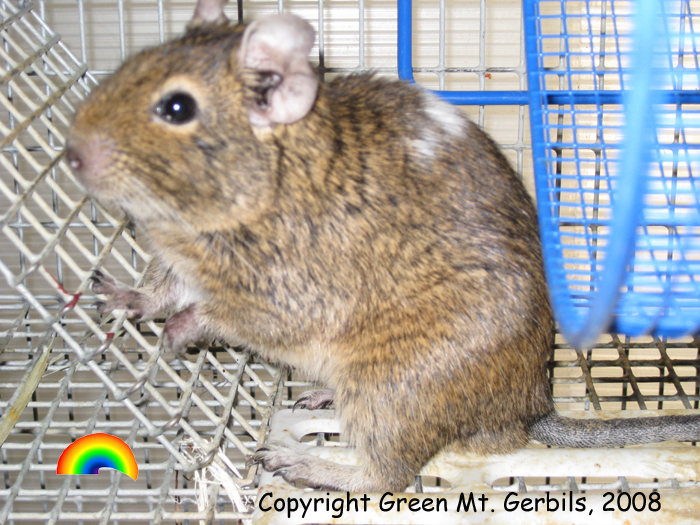
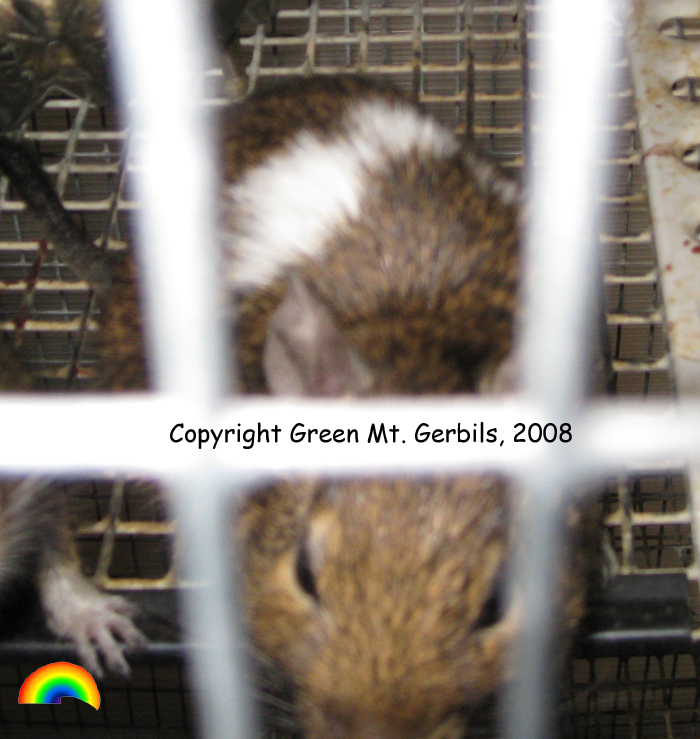
And Fancyfree (below)
developed his white patch when he was a couple of years old:
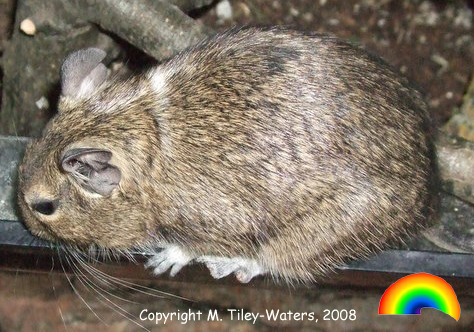
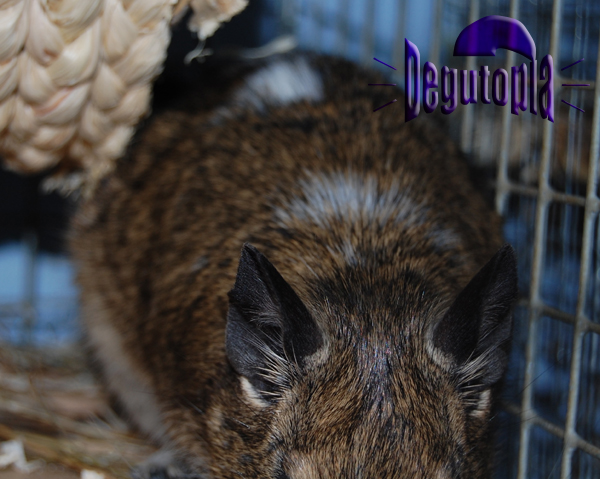
Eddy's age-patched degu
pictures © copyright Keith (Green Mt. Gerbils, US); Fancyfree's age-patched degu
pictures © copyright Melissa Tiley-Waters (UK) 2008 & Chloe Long (UK) 2009- it is unlawful to take these
pictures without permission of the copyright holder.
>"WHITE" DEGUS<
CODE = * * C* * * W* (superscheke)
CODE = * * cc * * * (albino [hypothetical])
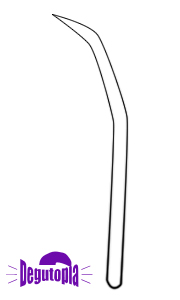
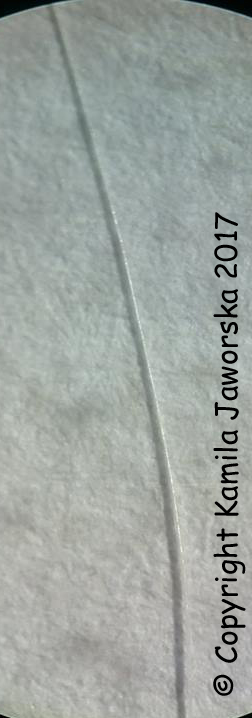
Structure of a white hair
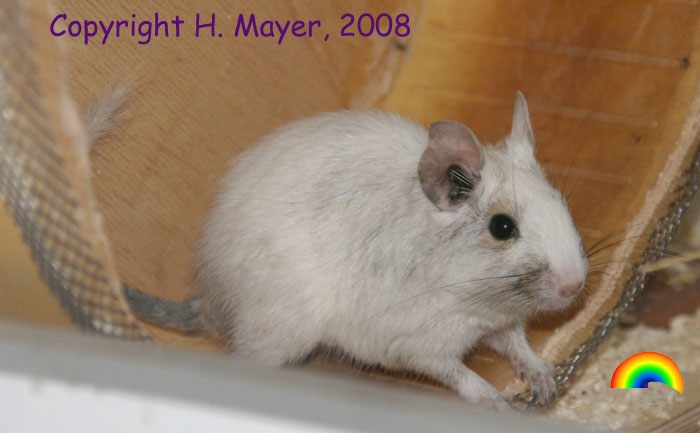
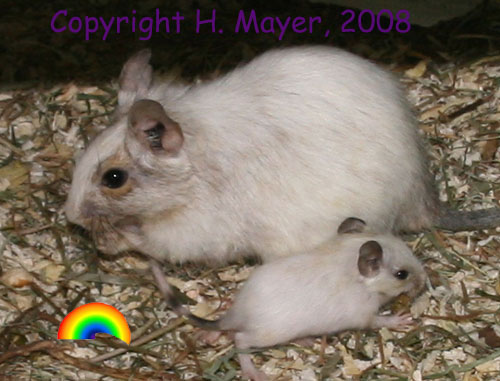
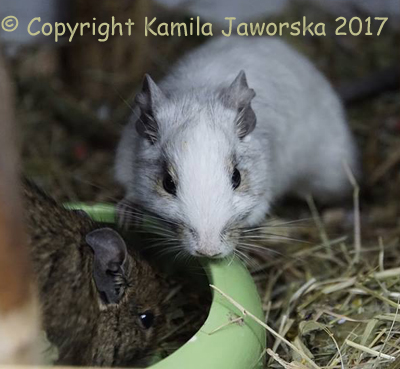
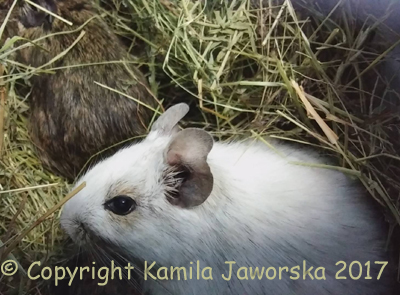
The degree to which the above
degus are truly white needs clarifying. True white or albino degus have yet to
be bred, the reason why this common mutation has not yet arisen is unknown.
Albino animals are born without pigment of any sort, and so have pink skin and
also pink eyes. It may be that, as in the horse, the recessive genes which cause albinism
to be expressed at locus C are lethal. Of the white degus that are produced, two types appear to exist; those in which the
pigment exists in the skin but is prevented from entering the hair follicle as a result of being extensively white patched ('superscheke'), and
those in which the degu is born agouti but the coat turns white at a later stage
(this is a very rare genetic condition). Mayer (2008) reports that white degu
varieties are born with pink skin that becomes grey as they develop (but the
hair remains white all the way down). Pigmentation may also be found in some of
the nails, whiskers, ears, and in the hair around the eyes. Below are two white pups, only a few days old.
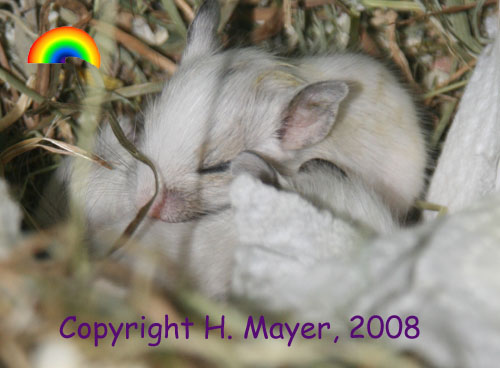
You can see the white coat is quite distinctive:
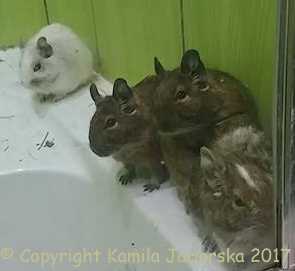
White degu pup and adult
pictures (upper) © copyright Hanni Mayer (Germany) 2008; adult white degu pictures (lower) © copyright Kamila Jaworska (Poland, DEGU Stacja) 2017- it is unlawful to take these
pictures without permission of the copyright holder.
